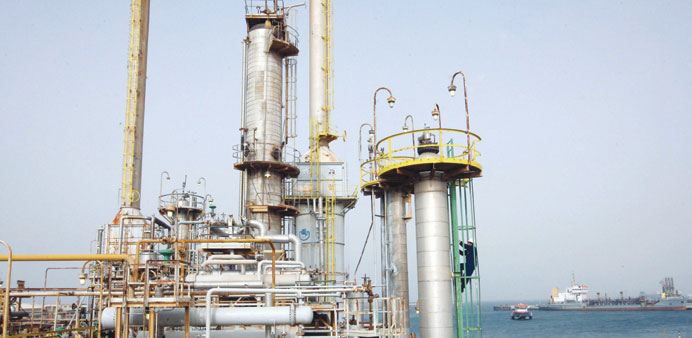Libyan employees of the Sirte Oil Company operate in the oil refining section of the company, in Brega, eastern Libya (file). Striking security guards and other worker protests have blocked the country’s main ports since end July and led to the closure of many oilfields, cutting exports and production to their lowest levels, with exports less than 500,000 bpd, since the civil war in 2011.
Reuters/Tripoli/London
Libya’s struggle with oil exports disruption intensified yesterday with clashes at one port and moves to head off attempts by strikers to sell oil themselves at the largest crude terminal.
The head of Libya’s Petroleum Facilities Guard (PFG), Edris Abokhamada, said he had contacted the defence ministry for reinforcements after clashes at the Zueitina oil port, which has been shut since mid-July.
“The protesters are still inside the port but the citizens want them to leave,” Abokhamada told Reuters, “The Zueitina port protesters fired on civilians when they asked them to leave - one is injured”.
Independent confirmation of the shooting was not immediately available.
Local resistance to strikes has shown the stranglehold on Libya’s vital oil exports loosening, industry sources in the country say. A second oil port, Marsa al Brega, reopened yesterday.
Abokhamada said that the protesters at Zueitina were allied with Ibrahim al-Jathran, the leader of strikers at the biggest oil port, Es Sider, who before his dismissal was PFG leader in central Libya.
The government has said workers have demanded higher pay and want to export oil independently, although the protestors have not voiced demands themselves.
The Libyan port authority asked their customers to remove their tankers from the Es Sider terminal late on Monday, trading and shipping sources said, to prevent any potential illegal oil sales.
One oil trading source said he had received emails offering Libyan oil outside of state National Oil Corp’s control.
Striking security guards and other worker protests have blocked the main ports since end July and led to the closure of many oilfields, cutting exports and production to their lowest levels, with exports less than 500,000 bpd, since the civil war in 2011. Before then export capacity was up to 1.25mn bpd.
Libya said last week it would use military force if necessary to prevent striking security guards from exporting oil independently.
The order for tankers to leave Es Sider is unusual, one trader said, and came after the state oil company declared force majeure on exports from four ports due to striking security guards.
“With a new person in charge of port authorities and talk of illegal shipments, they just want to clear the ports,” the trader said. “All vessels at Es Sider anchorage should sail urgently,” the shipping source said.
Mohammed Hattab, a spokesman for the oil workers’ union at Waha Oil Co, said the tankers were told to leave.
He added that the A Whale tanker moved out of the port zone.
Port workers have been trying to contact the tanker with no success. Sources said it had been not chartered by a customer of state NOC.
Reuters AIS Live ship tracking showed that the tanker had moved away from the port but appeared to be at anchor again still close to Libya by 0925 GMT.
Waha is the joint venture between the National Oil Corp, and US companies Marathon, Hess and ConocoPhillips, that produces Libya’s main export grade Es Sider and controls the port.
Brega, with a capacity of around 90,000 bpd, is the second port to reopen this week, following Marsa al Hariga.
“The Brega port is open, one tanker is there loading,” Mohammed Hattab, spokesman and head of an oil workers union at Waha Oil Co, said yesterday.
It was not clear whether a tanker had yet berthed at Hariga but one tanker was told to be ready to load in a few days, a trading source said.
Output from oilfields, which feed Hariga and Libya’s largest refinery, has fallen to a trickle of some 10,000 bpd. Crude in storage was being used for the refinery and it was not clear how much there was to export.

